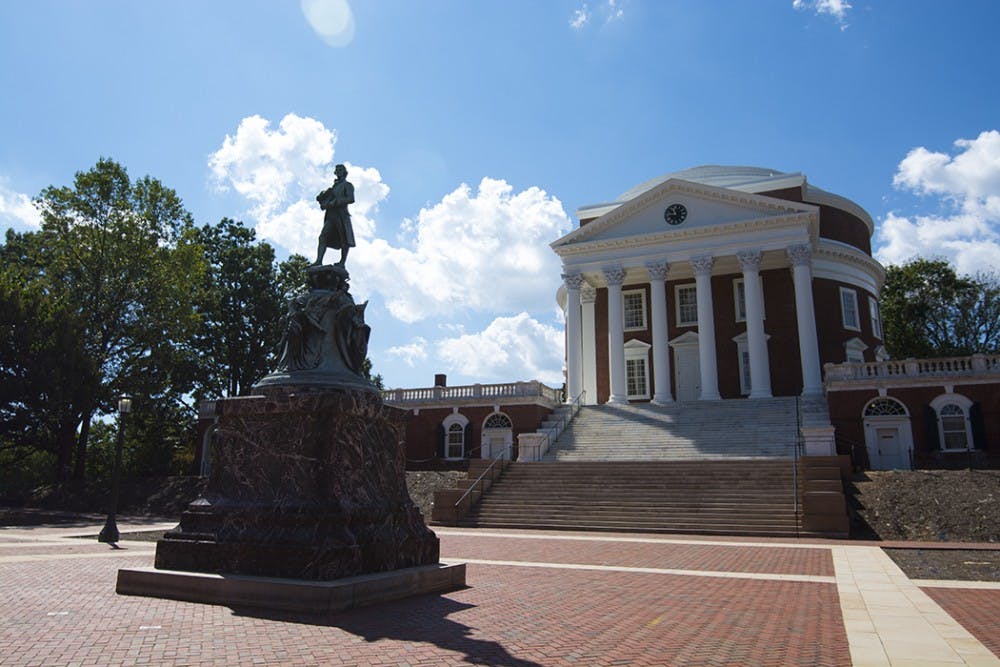After a $58 million dollar undertaking, renovations to the University’s Rotunda are complete. The building will be open to the public beginning Sept. 26.
With the University’s bicentennial quickly approaching, the renovation project had several goals to help restore the Rotunda to both the appearance and function of Thomas Jefferson’s original designs.
“With the advent of the bicentennial, the enthusiasm for Jefferson’s sufficient project was created to remove the 1890s interior and recreate Jefferson’s design,” University Senior Preservation Planner Brian Hogg said. “What you’re seeing is an advocation of the design that Jefferson had for this building.”
University architect Alice Raucher said the most dramatic change to the Rotunda is the renewed use of the building itself.
“The building and the landscape will once again be the active heart of the Lawn, with classes, discourse, quiet studying and celebrations,” Raucher said.
The Rotunda will have extended hours three days a week, Hogg said. By using their IDs to swipe in, students will have access to the building after hours — from 5 p.m. to 10 p.m. — to use for studying. During final exams, the building will remain open as late as midnight.
Changes to help better integrate the Rotunda into student life can be seen throughout the building. On the top floor, new features have been added to the Dome Room to create more study space for students.
A staircase has been added to the south side of the room, making the first balcony accessible to the public for the first time since its recreation in the 1970s. Furniture and tables line the entire area of the balcony, creating a study space for students that circles the Dome Room.
The lining of the ceiling of the Dome Room was replaced with acoustical plaster that is engineered to manage the noise and reverberations that a circular room creates, Hogg said. Previously, the ceiling had been lined with perforated metal panels.
Each quarter of the ceiling was completed in a single day, taking four days to go around the ceiling once.
Additionally, the capitals in the colonnade were replaced to include new ones that more closely matched the originals.
Using pictures of the originals, Tektonics Design Group from Richmond worked to create more authentic, wooden capitals.
“[Tektonics] made clay models of the capitals that were then revised and revised and revised and ultimately scanned, digitally,” Hogg said. “Most of the carving was done by computer carving machines, and the last 25 percent or so was finished by hand. These are much closer to the appearance of the originals than what was previously in place.”
The second floor of the building holds the room in which Hogg said the biggest changes were made.
Previously named the “Museum Room” with a rope across the door that prevented public access, the room has been repurposed to a place where students can study. Comfortable furniture, new tables and chairs have been added to allow a place for students to work.
While the second floor saw few architectural changes, other changes were made for increased function and added technology. The walls and ceilings now hold wireless stations and other improved communication technology as well as improved smoke detectors and sprinkler systems.
The bottom floor of the Rotunda holds classroom space and a visitors’ center.
The visitors’ center contains various artifacts, including the astronomical clock and busts of Jefferson and the Marquis de Lafayette. It also includes information about Jefferson’s vision for the University and Academical Village, the 1895 Rotunda fire and a general overview of the history of the University.
The room also contains some of the Rotunda’s more unique surprises.
One of these surprises is a fake window contained inside the room’s fireplace. When viewed from the outside, the room appears to have five windows encircling it. However, while standing on the inside, visitors will notice there are only four windows.
A 2013 discovery within the walls of the room is also visible in the visitors’ center.
“One of the discoveries that has been written about through the course of the project is the chemical hearth at the north end of the room, which was an early part of the apparatus for teaching chemistry at the University in the 1820s,” Hogg said.
Hogg said changes to the exterior of the Rotunda include a new copper roof and oculus, new marble capitals and a more welcoming North plaza.
Changes were also made to the east and west courtyards. While the courtyards were originally created in the 1890s after the Rotunda fire and were garden spaces in the past, they were heavily shaded and not inviting, Hogg said.
They were redesigned with the idea that they could be public spaces in which people could gather.
“You will see a water garden in the Darden Courtyard, which is a quieter, more meditative space, while the Shannon Courtyard on the west side of the Rotunda is brick-paved and able to accommodate tables and chairs to expand the adjacent multifunction space through pairs of French doors,” Raucher said.
A 25-foot excavation was made under the Darden courtyard, and it now holds a mechanical room that houses upgraded heating, cooling and plumbing systems. There is also space for catering services to prepare for events.
The multipurpose room attached to the Shannon courtyard is available to anyone at the University for use, including CIOs. The room holds approximately 40-60 people and features an exposed brick wall, which was the original wall from the Jefferson era.
“Daily life is hard on 200-year-old buildings, and the fact they function today as they once did is remarkable,” said Raucher. “Brian likes to say that our facilities suffer not from neglect, but from being too-well-loved and too-well used. I think Mr. Jefferson would very much appreciate that.”







